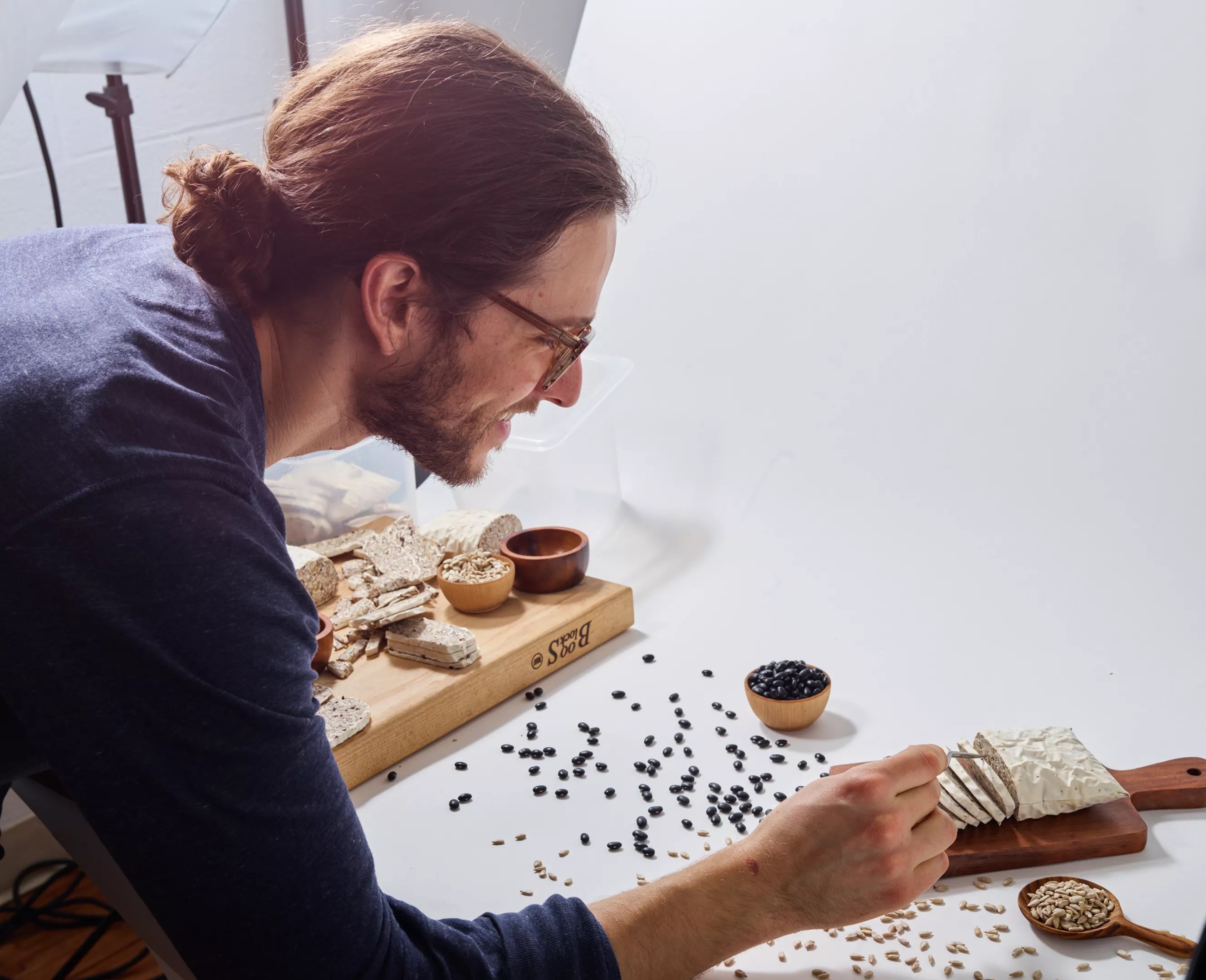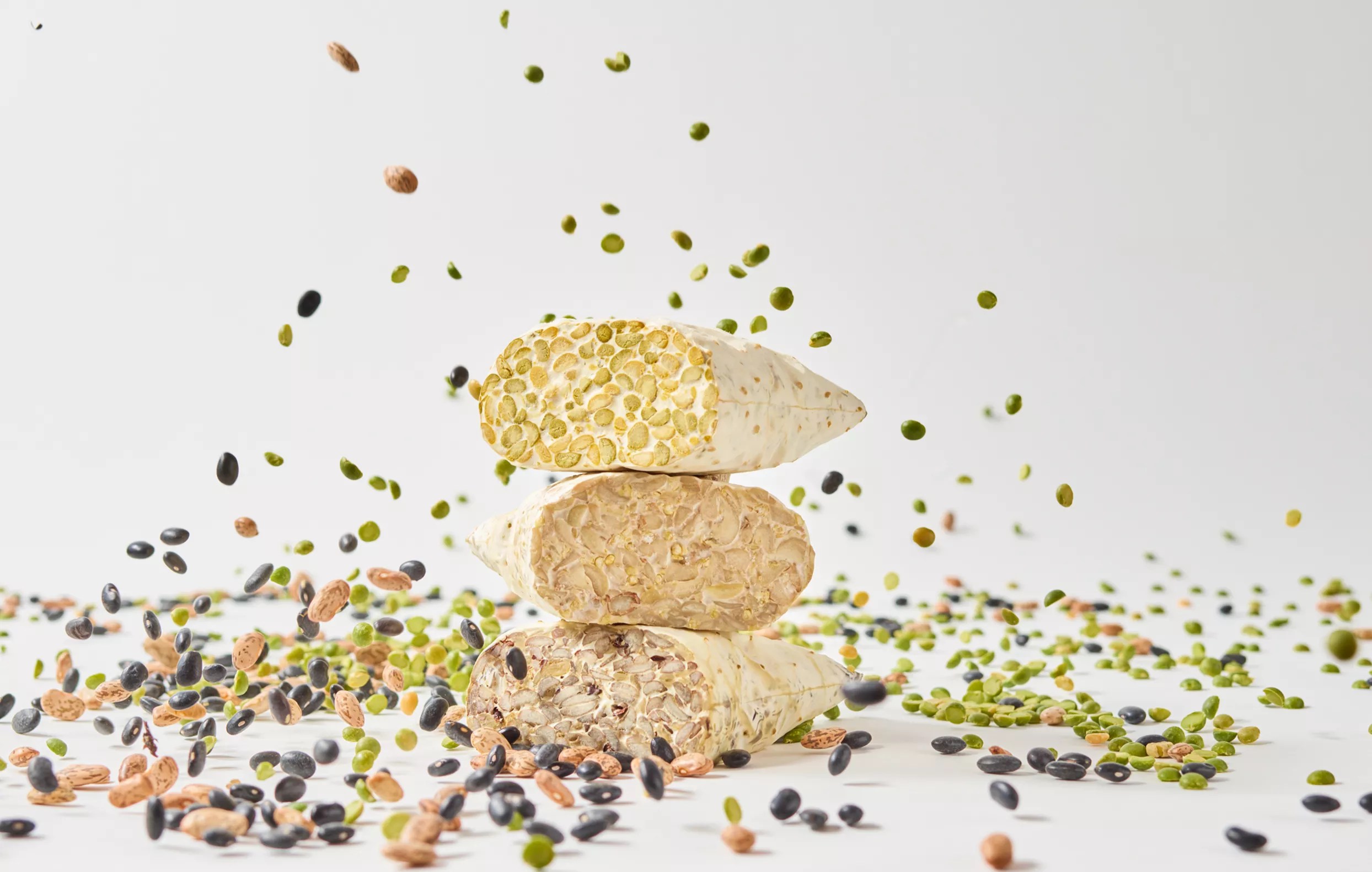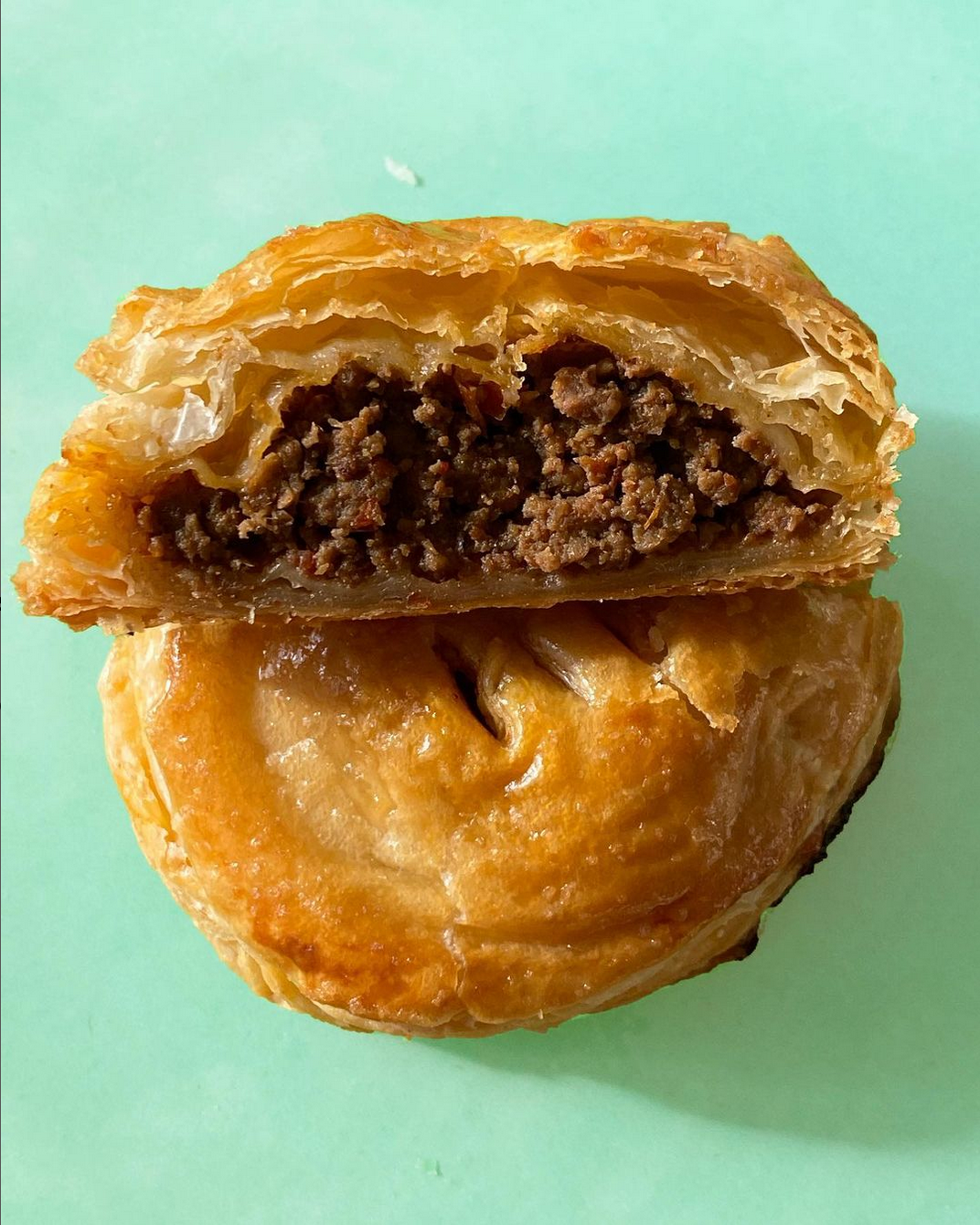
Judy Doherty Photography and Project Umami

Audio By Carbonatix
Farmers’ market season is back. No matter your neighborhood, you can find local produce and handcrafted goodies near you. In Farmers’ Market Finds, recipe developer and freelance writer Ashlee Redger highlights some standout local farmers’ market vendors and dishes up a recipe using their goods.
Vendor: Project Umami
Where to find it: Project Umami’s tempeh is available at local retail stores like Lucky’s Market and Leevers Locavore year-round. It also recently added a storefront at 2430 30th Street, Boulder, which is open from 10 a.m. to 4 p.m. Monday through Friday. During farmers’ market season, you can find the Project Umami stand at the Boulder and Longmont farmers’ markets on Saturdays, Highlands and South Pearl Street markets on Sundays and the Boulder evening market on Wednesdays.
For more info: Visit projectumami.net
About the business: Even a short conversation with Griffin Giordano reveals not only his unbridled enthusiasm for eating healthful, whole foods, but also his dedication to mastering the art (and science) of intentional eating. He excitedly dives into conversations about regenerative agriculture, seasonal eating and what it means for food to be more nutritionally “bioavailable” (more on this later). Since creating Project Umami in 2021, he has shared his passion with others through his unique legume-based tempeh and miso pastes.
Giordano says his obsession with food started early. “I was kind of like a macrobiotic baby,” he says. “I was eating nori rolls and apparently I was drinking soy milk instead of regular milk and things of that nature.” He remembers the kitchen being an essential part of his upbringing, heavily influenced by his Italian grandmother and mother – the latter of whom studied macrobiotic cooking in New York, where Giordano is from. For the unfamiliar, the macrobiotic diet focuses on plant-based, fiber-rich and locally grown organic foods. It was popular in the ’60s and ’70s, and although the diet itself has largely fallen out of public consciouness in favor of other fad plans, many of its characteristics still match common health tropes of today. It’s also worth mentioning here: Never make significant changes to your diet without consulting a medical professional first.

Giordano left his career in real estate development and started Project Umami in 2021.
Judy Doherty Photography and Project Umami
As a young adult, Giordano continued cooking for himself, sourcing almost all of his produce at farmers’ markets and avoiding any overly processed or preserved food. When the pandemic hit in 2020, he was studying for a graduate degree in real estate development from NYU and spending time in Colorado hiking, climbing and doing yoga in San Miguel County. After enjoying from the rich produce availability of the Hudson Valley, he was shocked by the lack of fresh, local fruits and vegetables. “There was no food,” he recalls. “I was more active than probably I’ve ever been in my life, and I just wasn’t getting enough calories.” Then came tempeh.
“Tempeh was a product that kind of presented itself to me,” Giordano remembers. He got his first taste from a Durango-based vendor at a farmers’ market in Telluride, Luv Tempeh. He bought a few of each variety that the stand carried and started incorporating them into his diet. “All of a sudden, I wasn’t calorie-deficient,” he says. Giordano returned to New York to finish his degree, but immediately came back to Colorado on vacation after graduating to learn from the original owner of Luv Tempeh, Maddalena Tumminaro, how to make the nutrient-rich product.
When he bounced back to New York, he further immersed himself in the world of tempeh by training remotely with a producer in Indonesia (where tempeh originated). In his studio apartment, Giordano mastered the process of inoculating bags of legumes with strains of Rhizopus fungus and then letting them ferment, transforming the ingredients from loose beans into firm, sliceable blocks held together by a network of mycelium.

Project Umami’s tempehs come in three flavors: Black Bean & Sunflower Seed, Colorado Pinto Bean & Millet and Green & Yellow Split Pea.
Judy Doherty Photography and Project Umami
“Things were changing a lot for me at that time, on a number of different fronts. Not just professionally, but also personally,” Giordano says. Instead of continuing his burgeoning career in real estate development, he decided to form a tempeh company. After some cursory research, he opted to return to Colorado to manufacture tempeh for the “vegans, vegetarians and health-conscious individuals” of the Front Range. Everything fell into place after that: He incorporated Umami Foods in March 2021, moved in May and was selling at the Boulder Farmers Market by June.
Normally, tempeh is made using soybeans, but Project Umami specializes in non-soy varieties. Giordano says this is for better diversity in one’s diet, and to avoid the harmful impacts of monocropping that come with soybean production in the United States.
The staple three tempehs that Project Umami offers are Black Bean & Sunflower Seed, Colorado-sourced Pinto Bean & Millet, and Green & Yellow Split Pea. While the ingredients may not be traditional, Giordano says that the methods he uses are.
The legumes are soaked for 24 hours in a warm environment before they are inoculated to give them a chance to sprout and begin fermentation on their own – a step that is often skipped by commercial manufacturers. This allows the beans to break down slightly and makes the nutrients more readily absorbable when eaten (hence, increasing the “bioavailability” of the nutrients). Project Umami also produces unconventional, probiotic miso pastes from white chickpeas, black beans and yellow peas.
Recently, Project Umami moved out of its commissary kitchen and into its own manufacturing facility at 2430 30th Street in Boulder, which includes its own small storefront that is open from 10 a.m. to 4 p.m. Monday through Friday. With the move came a redesign of the packaging in order to make the products more friendly for grocery stores and other retail settings.
The product line is also growing to include a few ready-to-eat options made out of pre-marinated and cooked split pea tempeh. These burger patties and protein strips – which come in savory maple, barbecue and za’atar oregano flavors – are for sale in limited quantities right now, but will become increasingly available at farmers’ markets and retail outlets as production ramps up.

With a sweet, salty and smoky glaze, this tempeh is a great replacement for bacon in BLT sandwiches.
Ashlee Redger
How to use it: Tempeh is super adaptable and can be sliced, cut into cubes or broken into crumbles to suit a variety of uses. Like tofu, it can soak up a ton of flavor from whatever marinade or sauce it’s soaked in (before or during cooking). Using crumbled tempeh in tomato sauce for pasta can be an easy, weekday vegetarian meal, or you can add it to a stir-fry with veggies and rice.
I love tempeh slices as a replacement for bacon in BLTs, so I used Project Umami’s Black Bean and Sunflower Seed variety to make glazed, smoky strips that complement late-season tomatoes. Grab whichever tempeh you prefer, then try it out for yourself. A little liquid smoke goes a long way; if you don’t have any, feel free to use 1/2 teaspoon of smoked paprika instead.
Smoky Glazed Tempeh
- 1/4 cup tamari or soy sauce
- 2 tablespoons rice vinegar
- 2 tablespoons maple syrup
- 1/2 teaspoon cornstarch
- 1/8 to 1/4 teaspoon red pepper flakes (optional)
- 1/16 teaspoon liquid smoke (Just use a few drops! Be careful not to overdo it.)
- 2 tablespoons olive oil (or whatever oil you usually like to cook with)
- 8 oz. Project Umami tempeh (your choice of flavor), cut crosswise into 1/4-inch slices
- Combine tamari, vinegar, maple syrup, cornstarch, red pepper flakes and liquid smoke in a small bowl, stir to dissolve the cornstarch, and set aside.
- Heat oil in a large skillet over medium-high heat. Add tempeh slices and cook until browned and crisped, about three to four minutes per side. Cook the slices in batches if needed to give each one enough room to make full contact with the pan. Add another drizzle of oil any time the pan starts looking dry.
- If you cooked the slices in batches, add all the tempeh back into the skillet. Reduce heat to medium-low and add glaze mixture. Gently swirl the pan and use tongs to flip the tempeh until all of the slices are fully coated. Continue cooking until the glaze is thickened and glossy (two to three minutes), then remove from heat.
- Enjoy the tempeh as a bacon substitute on TLT sandwiches or serve alongside rice and sautéed vegetables.

Café Tres makes Cuban pastelitos and cafecitos for the City Park Farmers Market every Saturday.
Café Tres/Instagram
Bonus Farmers’ Market Finds: We’re nearing the frantic final weeks of summer, but don’t let trite things like work or your kids going back to school distract you. It’s farmers’ market time – almost everything is in season right now. Here’s what I’m scouting the markets for this weekend:
- In late summer, my first stop is always Ela Family Farms for peaches and apples. The stand also has limited quantities of heirloom tomatoes that you can snag if you’re lucky. This is also about the time I like to start asking about cider, even though I know it doesn’t come until around October (it’s just that good).
- Follow your nose to the green chile stand and stock up. Fresh Pueblo (and Hatch) chiles are harvested around August, but they freeze well for year-round use. Just make sure you peel off the blackened skin and squeeze out the seeds beforehand. Later-you will love current-you for the head start.
- Café Tres is making mind-blowingly awesome Cuban pastries and cafecitos every Saturday for the City Park Farmers’ Market. The offerings vary a little from week to week, but do not pass by a carne pastelito if you see one. The intensely savory and salty meat combined with the glazed flaky pastry sends me into a daydream every time I think of it.